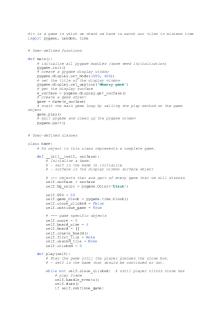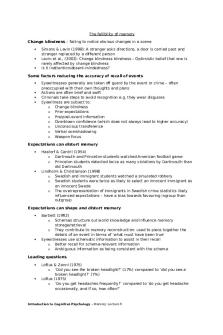Memory Hierarchy Basics PDF

| Title | Memory Hierarchy Basics |
|---|---|
| Course | Arsitektur Komputer |
| Institution | Universitas Sriwijaya |
| Pages | 19 |
| File Size | 1.6 MB |
| File Type | |
| Total Downloads | 268 |
| Total Views | 401 |
Summary
MemoryHierarchyBasicsIntroduction Programmers want unlimited amounts of memory with low latency Fast memory technology is more expensive per bit than slower memory Solution: organize memory system into a hierarchy Entire addressable memory space available in largest, slowest memory Incrementally sma...
Description
Memory Hierarchy Basics
Introduction – Programmers want unlimited amounts of memory with low latency – Fast memory technology is more expensive per bit than slower memory – Solution: organize memory system into a hierarchy – Entire addressable memory space available in largest, slowest memory – Incrementally smaller and faster memories, each containing a subset of the memory below it, proceed in steps up toward the processor
– Temporal and spatial locality insures that nearly all references can be found in smaller memories – Gives the allusion of a large, fast memory being presented to the processor
2
Memory Hierarchy
3
Memory Performance Gap
4
Memory Hierarchy Design – Memory hierarchy design becomes more crucial with recent multi-core processors: – Aggregate peak bandwidth grows with # cores: – Intel Core i7 can generate two references per core per clock – Four cores and 3.2 GHz clock – 25.6 billion 64-bit data references/second + – 12.8 billion 128-bit instruction references – = 409.6 GB/s!
– DRAM bandwidth is only 6% of this (25 GB/s) – Requires: – Multi-port, pipelined caches – Two levels of cache per core – Shared third-level cache on chip
5
Performance and Power
– High-end microprocessors have >10 MB on-chip cache – Consumes large amount of area and power budget
6
Memory Hierarchy Basics
– When a word is not found in the cache, a miss occurs: – Fetch word from lower level in hierarchy, requiring a higher latency reference – Lower level may be another cache or the main memory – Also fetch the other words contained within the block – Takes advantage of spatial locality
– Place block into cache in any location within its set, determined by address – block address MOD number of sets 7
Memory Hierarchy Basics – Hit: data appears in some block in the upper level (example: Block X) – Hit Rate: the fraction of memory access found in the upper level – Hit Time: Time to access the upper level which consists of RAM access time + Time to determine hit/miss
– Miss: data needs to be retrieved from a block in the lower level (Block Y) – Miss Rate = 1 - (Hit Rate) – Miss Penalty: Time to replace a block in the upper level + Time to deliver the block the processor
– Hit Time n-way set associative – Direct-mapped cache => one block per set (one-way) – Fully associative => one set – Place block into cache in any location within its set, determined by address – block address MOD number of sets
– Writing to cache: two strategies – Write-through – Immediately update lower levels of hierarchy
– Write-back – Only update lower levels of hierarchy when an updated block is replaced
– Both strategies use write buffer to make writes asynchronous 9
Q4: What happens on a write? Write-Through
Policy
Data written to cache block
Write-Back Write data only to the cache
also written to lowerlevel memory
Update lower level when a block falls out of the cache
Debug
Easy
Hard
Do read misses produce writes?
No
Yes
Do repeated writes make it to lower level?
Yes
No
Additional option (on miss)-- let writes to an un-cached address; allocate a new cache line (“write-allocate”). 10
Write Buffers for Write-Through Caches Cache
Processor
Lower Level Memory
Write Buffer
Holds data awaiting write-through to lower level memory Q. Why a write buffer ? Q. Why a buffer, why not just one register ? Q. Are Read After Write (RAW) hazards an issue for write buffer?
A. So CPU doesn’t stall
A. Bursts of writes are common. A. Yes! Drain buffer before next read, or send read 1st after check write buffers. 11
Memory Hierarchy Basics – Hit rate: fraction found in that level – So high that usually talk about Miss rate – Miss rate fallacy: as MIPS to CPU performance, miss rate to average memory access time in memory
– Average memory-access time = Hit time + Miss rate x Miss penalty (ns or clocks) – Miss penalty: time to replace a block from lower level, including time to replace in CPU – access time: time to lower level = f(latency to lower level)
– transfer time: time to transfer block =f(BW between upper & lower levels, block size) 12
Memory Hierarchy Basics
– Miss rate – Fraction of cache access that result in a miss
– Causes of misses – Compulsory – First reference to a block, also called “cold miss”
– Capacity – Blocks discarded (lack of space) and later retrieved
– Conflict – Program makes repeated references to multiple addresses from different blocks that map to the same location in the cache
13
Memory Hierarchy Basics
– Note that speculative and multithreaded processors may execute other instructions during a miss – Reduces performance impact of misses 14
Improve Cache Performance improve cache and memory access times: Average Memory Access Time = Hit Time + Miss Rate * Miss Penalty
Reducing each of these! Simultaneously?
CPUtime IC * (CPI Execution •
MemoryAccess Instruction
* MissRate * MissPenalty * ClockCycleTime)
Improve performance by: 1. Reduce the miss rate, 2. Reduce the miss penalty, or 3. Reduce the time to hit in the cache. 15
Memory Hierarchy Basics – Six basic cache optimizations: – Larger block size –
Reduces compulsory misses
–
Increases capacity and conflict misses, increases miss penalty
– Larger total cache capacity to reduce miss rate –
Increases hit time, increases power consumption
– Higher associativity –
Reduces conflict misses
–
Increases hit time, increases power consumption
– Higher number of cache levels –
Reduces overall memory access time
– Giving priority to read misses over writes –
Reduces miss penalty
– Avoiding address translation in cache indexing –
Reduces hit time
16
The Limits of Physical Addressing “Physical addresses” of memory locations A0-A31
A0-A31
CPU
Memory
D0-D31
D0-D31
Data
oAll programs share one address space: The physical address space oMachine language programs must be aware of the machine organization oNo way to prevent a program from accessing any machine resource 17
Solution: Add a Layer of Indirection “Physical Addresses”
“Virtual Addresses” A0-A31
Virtual
CPU
Physical
Address Translation
D0-D31
A0-A31
Memory D0-D31
Data
• User programs run in a standardized virtual address space • Address Translation hardware, managed by the operating system (OS), maps virtual address to physical memory •Hardware supports “modern” OS features: Protection, Translation, Sharing 18
THANKS
19...
Similar Free PDFs

Memory Hierarchy Basics
- 19 Pages

Maslow\'s Hierarchy
- 1 Pages

Brand Hierarchy
- 2 Pages

Memory
- 3 Pages

Memory
- 5 Pages

BH 1 - Brand Hierarchy
- 1 Pages

Hierarchy in International Relations
- 46 Pages

Analytical Hierarchy Process
- 40 Pages

Hierarchy of authority
- 2 Pages

Maslow\'s Hierarchy of Needs
- 1 Pages

Hierarchy and ISDA documentation
- 5 Pages

Test Documentation Hierarchy
- 2 Pages

Virtual Memory
- 58 Pages

CACHE MEMORY
- 1 Pages

Memory Psych
- 1 Pages
Popular Institutions
- Tinajero National High School - Annex
- Politeknik Caltex Riau
- Yokohama City University
- SGT University
- University of Al-Qadisiyah
- Divine Word College of Vigan
- Techniek College Rotterdam
- Universidade de Santiago
- Universiti Teknologi MARA Cawangan Johor Kampus Pasir Gudang
- Poltekkes Kemenkes Yogyakarta
- Baguio City National High School
- Colegio san marcos
- preparatoria uno
- Centro de Bachillerato Tecnológico Industrial y de Servicios No. 107
- Dalian Maritime University
- Quang Trung Secondary School
- Colegio Tecnológico en Informática
- Corporación Regional de Educación Superior
- Grupo CEDVA
- Dar Al Uloom University
- Centro de Estudios Preuniversitarios de la Universidad Nacional de Ingeniería
- 上智大学
- Aakash International School, Nuna Majara
- San Felipe Neri Catholic School
- Kang Chiao International School - New Taipei City
- Misamis Occidental National High School
- Institución Educativa Escuela Normal Juan Ladrilleros
- Kolehiyo ng Pantukan
- Batanes State College
- Instituto Continental
- Sekolah Menengah Kejuruan Kesehatan Kaltara (Tarakan)
- Colegio de La Inmaculada Concepcion - Cebu
